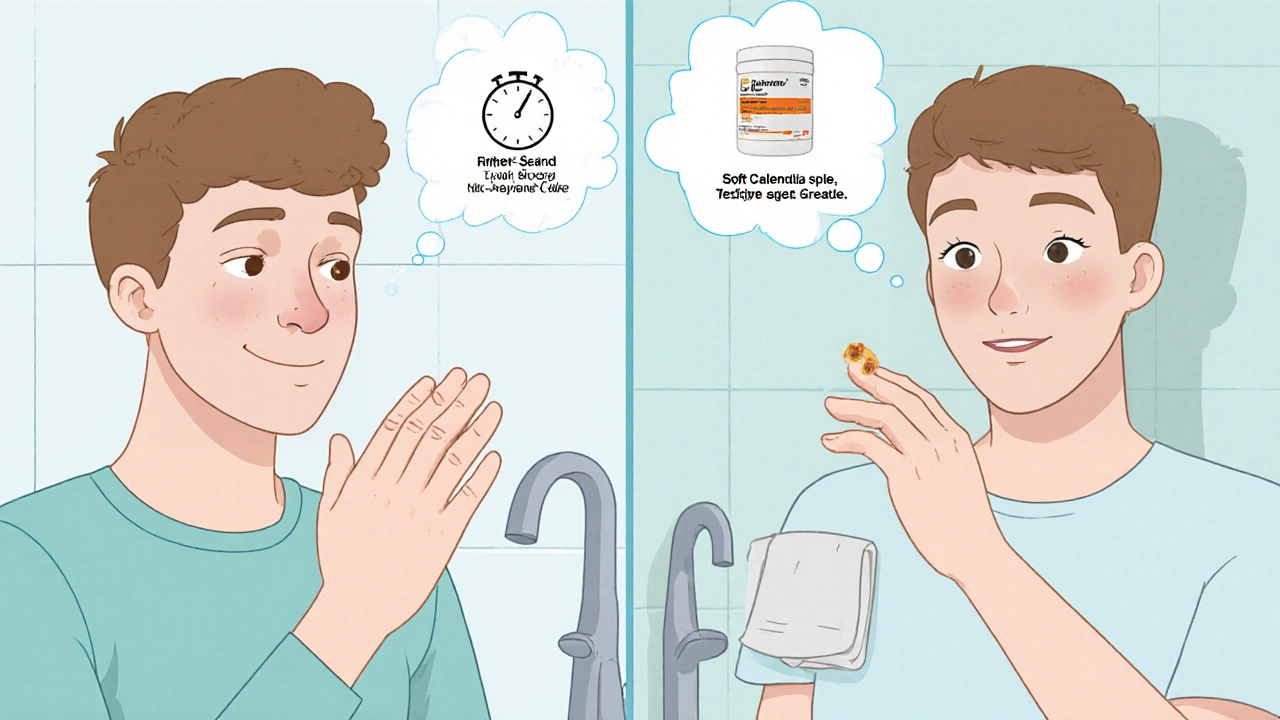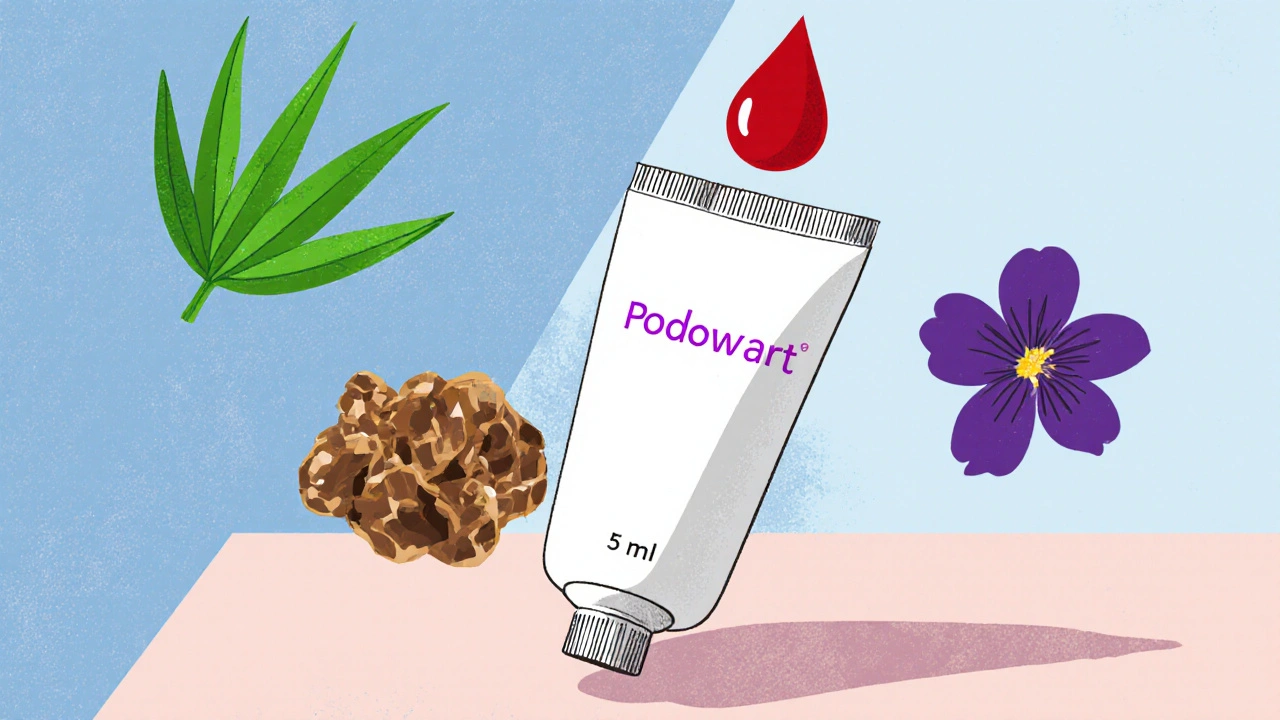Key Takeaways
- Podowart blends Podophyllum resin, Benzoin, and Aloe Vera for wart removal and skin soothing.
- Its strength lies in fast wart clearance but it can irritate sensitive skin.
- Tea tree oil, witch hazel, zinc oxide ointment, salicylic acid, and calendula extract are common alternatives with varying safety profiles.
- When choosing, weigh effectiveness, irritation risk, cost, and availability.
- For mild irritation or daily skincare, Aloe‑based gels or witch hazel may be gentler than Podowart.
What Is Podowart?
When you see the name Podowart is a topicalpreparation marketed for wart removal and minor skin irritations. It combines three active botanicals-Podophyllum resin, Benzoin and Aloe Vera-to deliver a blend of keratolytic, anti‑inflammatory, and soothing effects.
The product is sold in small 5ml tubes, usually priced between $12‑$18 AUD, and is intended for short‑term use on a limited skin area.
How the Three Ingredients Work
Podophyllum resin (derived from thePlantain lily) contains podophyllotoxin, a potent mitotic inhibitor. By halting cell division, it softens the hardened tissue of warts, making them easier to lift off. Clinical reports from 2022 note up to a 70% clearance rate after three applications.
Benzoin is a resin from theSassafras tree. It acts as a natural antiseptic and creates a protective film on the skin, reducing bacterial contamination and providing a mild analgesic feel.
Aloe Vera gel is famous for its cooling, moisturizing, and anti‑inflammatory properties. It counteracts the drying effect of podophyllotoxin, helping the treated area stay supple and less painful.
Criteria to Compare Products
- Effectiveness on warts: How quickly the product clears common or plantar warts.
- Skin irritation potential: Reports of redness, burning, or allergic reactions.
- Cost per treatment: Price divided by typical number of tubes needed.
- Availability: Whether it’s OTC, prescription‑only, or online‑only.
- Additional uses: Benefits for burns, eczema, or general skin soothing.
Side‑by‑Side Comparison
| Product | Key Active(s) | Wart Clearance (Typical) | Irritation Risk | Cost (AUD) | Availability |
|---|---|---|---|---|---|
| Podowart | Podophyllum resin, Benzoin, Aloe Vera | ~70% after 3applications | Medium - mild burning reported in 12% | $12‑$18 per 5ml tube | OTC online, limited pharmacies |
| Tea Tree Oil (5% solution) | Terpinen‑4‑ol | ~30% after 4weeks | Low‑Medium - possible allergic dermatitis | $8‑$12 per 30ml bottle | Widely available OTC |
| Witch Hazel extract | Hamamelitannin, tannins | ~15% after 6weeks | Low - soothing for most skin types | $5‑$9 per 100ml | OTC, drugstores |
| Zinc Oxide Ointment | Zinc oxide (20%) | Not a wart treatment (protective only) | Very low - suitable for infants | $4‑$7 per 30g tube | OTC, pharmacies |
| Salicylic Acid 17% gel | Salicylic acid | ~55% after 2‑3weeks | Medium - can cause peeling, dryness | $10‑$14 per 15ml | OTC, pharmacies, online |
| Calendula Extract cream | Calendula officinalis | ~10% (mainly soothing) | Very low - ideal for sensitive skin | $9‑$13 per 50ml | OTC, health‑food stores |
Which Option Fits Different Needs?
- Fast wart clearance: Podowart’s podophyllum resin outpaces most OTC alternatives. Salicylic acid is a close second with a lower irritation profile.
- Gentle daily skincare: Witch hazel or Calendula cream provide soothing without the risk of burning.
- Burns or minor abrasions: Aloe Vera gel (stand‑alone) or Zinc oxide ointment create a protective barrier and keep moisture in.
- Budget‑conscious: Witch hazel and Zinc oxide are the cheapest per treatment cycle.
- Prescription‑only safety: If you have a history of skin allergies, stick to low‑irritant options like Calendula or plain Aloe gel.

Practical Tips for Using Podowart Safely
- Clean the area with mild soap and pat dry.
- Apply a pea‑sized amount directly on the wart, avoiding surrounding healthy skin.
- Leave on for 30‑45minutes, then gently wipe off with a damp cloth.
- Repeat every 48hours for up to three applications. If redness exceeds 5mm or severe pain occurs, stop and consult a pharmacist.
- Store the tube in a cool, dark place to preserve the resin’s potency.
When to Choose an Alternative Instead
If you notice any of the following, consider switching:
- Intense burning that lasts more than 15minutes after each use.
- Redness spreading beyond the treated spot.
- History of hyper‑sensitivity to resin‑based products.
In those cases, a low‑irritant option such as Calendula Extract cream or plain Aloe Vera gel can keep the skin calm while you look for a different wart treatment method.
Frequently Asked Questions
Is Podowart safe for children?
Podowart contains podophyllum resin, which is quite strong and not recommended for anyone under 12years old without medical supervision. For kids, gentler options like zinc oxide ointment or calendula cream are safer.
How does Podowart compare to over‑the‑counter salicylic acid patches?
Podowart typically clears warts faster-around 70% after three applications-while 17% salicylic acid gels achieve about 55% clearance over two to three weeks. However, salicylic acid is gentler and less likely to cause burning.
Can I use Podowart on facial warts?
Facial skin is thinner and more sensitive. The resin can cause noticeable irritation, so many dermatologists advise against it on the face. Consider a lower‑strength salicylic acid or a prescription retinoid instead.
How long does a single tube of Podowart last?
A 5ml tube typically covers 2‑3 small warts, assuming the recommended pea‑size dose per application. Most users finish a tube within 2‑3 weeks.
Are there any drug interactions with Podowart?
Because Podowart is applied topically and not absorbed systemically in large amounts, interactions are rare. However, if you’re using other potent topical agents (e.g., retinoids), stagger applications to avoid cumulative irritation.


Trina Smith
Reading through the comparison, I’m reminded how often we chase quick fixes without weighing the long‑term skin health 🌿. Podowart’s rapid wart clearance is impressive, yet the medium irritation risk can’t be ignored for sensitive users. The botanical trio is clever, especially the soothing aloe offsetting the resin’s harshness, but I’d still advise a patch test before a full application. Considering cost, the $12‑$18 price point sits between the cheap witch hazel and pricier salicylic gels, making it a middle‑ground option. Ultimately, balance effectiveness with your skin’s tolerance, and don’t forget the importance of proper aftercare 😊.